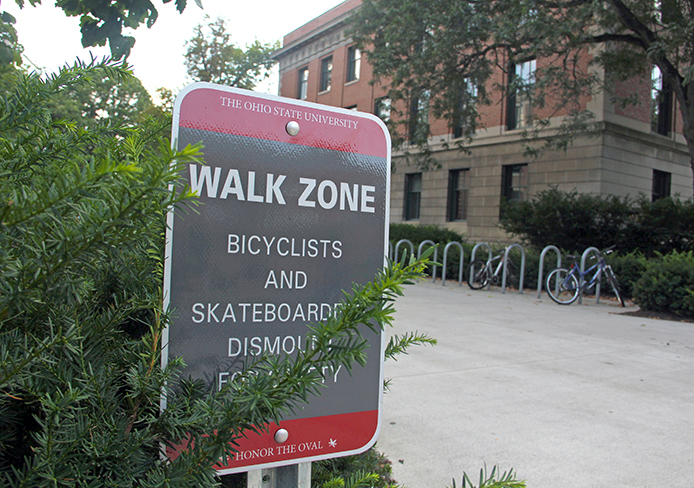
A safety sign outside Derby Hall noting the Walk Zone near the Oval.
Credit: Ritika Shah / Asst. photo editor
Ohio State’s Traffic Safety Task Force was implemented a year ago this month, but some OSU students still think there’s room for the program to improve.
The Traffic Safety Task Force was created in September 2012 in an attempt to increase safety after three traffic incidents on or near to campus left OSU students with major injuries. Lindsay Komlanc, OSU spokeswoman for Administration and Planning, said the measures have been timed to add on a new message related to traffic safety every so often.
“We wanted to take a logical approach,” Komlanc said. “First concentrating on pedestrian messaging, then moving onto motorist messaging and then bicycle messaging, and toward the end of Spring Semester we implanted the Walk Zone on the Oval because it really put all of those messages together.”
Those crossing the Oval with bikes are supposed to dismount and walk across, creating a “walk zone” Komlanc said, though, enforcement of that zone is not what’s key.
“While enforcement is part of any effort and a major part of traffic safety, writing citations is not the main focus of this campaign,” Komlanc said. “The main point is education, with enforcement to support needed behavior change.”
Komlanc said in an email there were 85 traffic offense citations issued and 40 warnings, including speeding, jaywalking and not following traffic control devices, issued from Jan. 1 through Sept. 1.
Some students said the safety zones were a positive addition to campus, but the campaign still needs more work.
“(The safety rules) should be more enforced but it’s a very good idea since there are so many students on campus,” said Sarah Buckalew, a second-year in Chinese who rides her bike around campus. “It’s about the awareness that you could hurt someone and that you need to be respectful of the detriments and that fact people have been hurt.”
Other students said the existing signs aren’t enough.
“If the point of the zones is awareness, put up more signs up along the path so it is completely obvious so that you cannot miss it, or put up a stop sign and make it more like traffic if they want the zones to work,” said Maggie Tamborski, a third-year in Chinese who also rides her bike to class.
While the university’s primary goal is awareness, Komlanc said University Police have had a visible presence on campus since the start of the semester, and officers have been issuing warnings related to jaywalking and other traffic safety violations. University Police also have the ability to write citations that come with fines rather than just warnings.
Buckalew said enforcement is more important than awareness.
“There should be at least one person related to the staff or a professor at the university who just walks around the Oval once a day and sees (people riding bikes through the area) because it could reduce the risks by a lot,” Buckalew said. “There should definitely be consequences for those who don’t follow the rules because people will respond to that.”
Tamborski said the requirement to dismount bikes and walk them through the Oval puts some students on a time crunch and can affect the time they get to class, possibly making them late.
“They should have a separate area (on the Oval) that’s just for bikes because I know I would have been late to class several times because I will have class either really close to (or on) the Oval and then have to go around to get to a road,” Tamborksi said.
Over the summer, a university-wide survey was conducted to get a basic understanding of how the spring pilot program was received. The responses received were used to help shape the direction of the program this fall and also help in future endeavors, Komlanc said.


